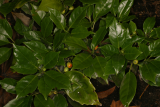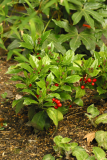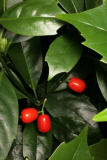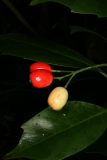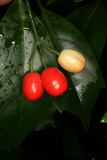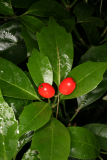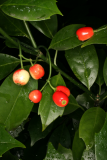Additional notes (click to expand)
Medicinal
The leaves are used in traditional Chinese medicine.
Plants for a Future at www.plantsforafuture.org.uk http://www.pfaf.org/user/Plant.aspx?LatinName=Aucuba+japonica
link
Nomenclature
Family name change from Aucubaceae 15/01/2021 A T
http://powo.science.kew.org/
Other use
Aucuba japonica Thunb. Acubaceae. Spottted laurel, Japanese laurel. Its Japanese name is aukubi. 'Rosannie' is an unspotted cultivar which has the Award of Garden Merit from the RHS, and is unusual in that it has both male and female flowers, so always produces berries. The original Aucuba japonica plants introduced in 1783 were female and it was not until Robert Fortune brought back a male plant in 1861 that berries could be produced on the female plants. It is only mildly poisonous, containing the alkaloid aucubin, unlike true laurel, Prunus laurocerasus, which contains a cyanogenic lipid which is converted to cyanide if the leaf is damaged. Aucubin is an iridoid glycoside, which defends the plant against herbivores, mostly insects which is probably why the leaves suffer little if any pest damage. There are no medical uses in western medicine although the leaves are used in traditional Chinese medicine.
Oakeley, Dr. Henry F. (2013). Wellcome Library notes.
link
Toxicity
It is only mildly poisonous, containing the alkaloid aucubin, unlike true laurel, Prunus laurocerasus, which contains a cyanogenic lipid which is converted to cyanide if the leaf is damaged. Aucubin is an iridoid glycoside, which defends the plant against herbivores, mostly insects which is probably why the leaves suffer little if any pest damage.
Oakeley, Dr. Henry F. (2013). Wellcome Library notes.
link
Aucuba japonica 'Rozannie'
Family: GARRYACEAEGenus: Aucuba
Species: japonica
Cultivar: 'Rozannie'
Common names: Spotted Laurel
Distribution summary: China, Japan, Taiwan
Habit: Shrub
Garden status: Not currently grown
Reason for growing: Medicinal
